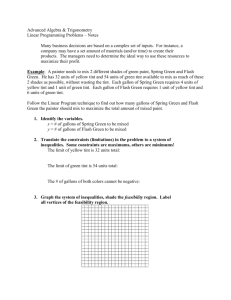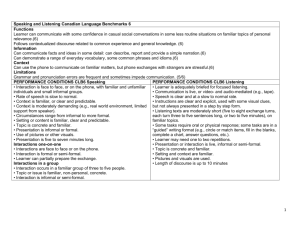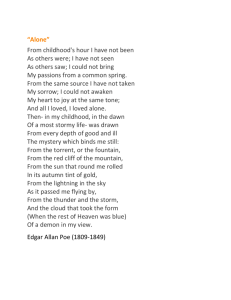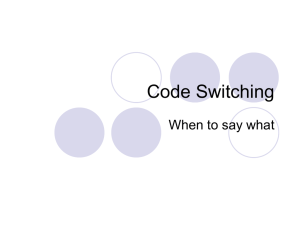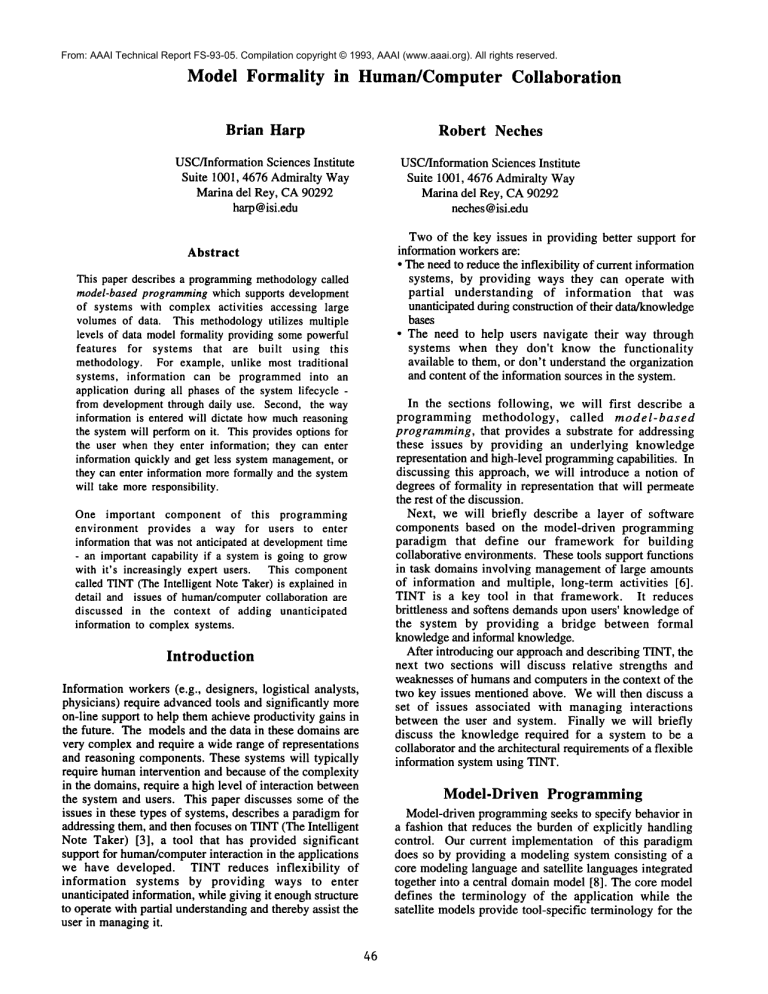
From: AAAI Technical Report FS-93-05. Compilation copyright © 1993, AAAI (www.aaai.org). All rights reserved.
Model Formality
in Human/Computer Collaboration
Brian Harp
Robert Neches
USC/InformationSciences Institute
Suite 1001, 4676 Admiralty Way
Marina del Rey, CA90292
harp@isi.edu
USC/InformationSciences Institute
Suite 1001, 4676 Admiralty Way
Marina del Rey, CA90292
neches@isi.edu
Twoof the key issues in providing better support for
information workersare:
° Theneed to reduce the inflexibility of current information
systems, by providing ways they can operate with
partial
understanding of information that was
unanticipated during construction of their data/knowledge
bases
¯ The need to help users navigate their way through
systems when they don’t know the functionality
available to them, or don’t understand the organization
and content of the information sources in the system.
Abstract
This paper describes a programming
methodologycalled
model-based programmingwhich supports development
of systems with complex activities accessing large
volumesof data. This methodologyutilizes multiple
levels of data modelformality providing somepowerful
features for systems that are built using this
methodology. For example, unlike most traditional
systems, information can be programmed into an
application during all phases of the systemlifecycle from developmentthrough daily use. Second, the way
information is entered will dictate howmuchreasoning
the systemwill performon it. This provides options for
the user whenthey enter information; they can enter
information quickly and get less systemmanagement,or
they can enter informationmoreformally and the system
will take moreresponsibility.
One important component of this programming
environment provides a way for users to enter
informationthat was not anticipated at developmenttime
- an important capability if a systemis going to grow
with it’s increasingly expert users. This component
called TINT(TheIntelligent NoteTaker) is explained
detail and issues of human/computer
collaboration are
discussed in the context of adding unanticipated
information to complexsystems.
Introduction
Information workers (e.g., designers, logistical analysts,
physicians) require advancedtools and significantly more
on-line support to help them achieve productivity gains in
the future. The modelsand the data in these domainsare
very complexand require a wide range of representations
and reasoning components. These systems will typically
require humanintervention and because of the complexity
in the domains,require a high level of interaction between
the system and users. This paper discusses some of the
issues in these types of systems, describes a paradigmfor
addressing them, and then focuses on TINT(The Intelligent
Note Taker) [3], a tool that has provided significant
support for human/computer
interaction in the applications
we have developed. TINT reduces inflexibility
of
information systems by providing ways to enter
unanticipated information, while giving it enoughstructure
to operate with partial understandingand thereby assist the
user in managingit.
46
In the sections following, we will first describe a
programming methodology,
called
model-based
programming, that provides a substrate for addressing
these issues by providing an underlying knowledge
representation and high-level programming
capabilities. In
discussing this approach, we will introduce a notion of
degrees of formality in representation that will permeate
the rest of the discussion.
Next, we will briefly describe a layer of software
components based on the model-driven programming
paradigm that define our framework for building
collaborative environments. These tools support functions
in task domains involving managementof large amounts
of information and multiple, long-term activities [6].
TINT is a key tool in that framework. It reduces
brittleness and softens demandsupon users’ knowledgeof
the system by providing a bridge between formal
knowledgeand informal knowledge.
After introducing our approach and describing TINT,the
next two sections will discuss relative strengths and
weaknesses of humansand computers in the context of the
two key issues mentioned above. Wewill then discuss a
set of issues associated with managing interactions
between the user and system. Finally we will briefly
discuss the knowledge required for a system to be a
collaborator and the architectural requirementsof a flexible
information system using TINT.
Model-Driven Programming
Model-driven programmingseeks to specify behavior in
a fashion that reduces the burden of explicitly handling
control. Our current implementation of this paradigm
does so by providing a modeling system consisting of a
core modelinglanguage and satellite languages integrated
together into a central domainmodel [8]. The core model
defines the terminology of the application while the
satellite modelsprovide tool-specific terminologyfor the
application.
An interface component is capable of
presenting all of the modelsin the representation system
so the user has a seamless view of the application.
A number of different languages are used within our
model-driven environment and they vary in their level of
expressiveness. It is generally believed that the more a
modeling language formally represents the semantic
content of an application the morethe systemcan infer and
"understand" about the data. The models produced from
these kinds of languages are called formal models [4].
Logic based languages such as Prolog and LOOM
[5] are
examplesof a formal modelinglanguage.
On the other hand, some types of information in an
application may be in a purely syntactic form (e.g.,
strings, numbers)with no domainspecific representation.
Wecall this type of modelan informal model. There are a
numberof reasons whythe data maybe informal:
¯ the developer may choose not to model it formally
becausethe extra detail is not required to meetthe goals
of the application
¯ the data maynot have been knownat development time
makingit impossible to build the modelto represent the
data. Thus, whenthe data is entered by the user it has to
be captured in a semantic-flee representation.
Semantic reasoning cannot be performed using only
informal information because the information is not
entered in a form that can be used by semantic reasoners..
However, integration
of formal and informal
representations is possible by storing informal information
in formal objects. (E.g., an attribute of an object may
contain a value of a string). If a formal modelis used in an
application and a user wants to assert someinformation
that doesn’t fit the model, systems typically give no
assistance in handlingit for the user. In applications where
this is the case, users typically have to record this informal
information externally in a paper system or utilize a
mechanism that is independent from the formal model
(e.g., a text editor to recordand savetext to files).
To help close the gap between formal and informal
models, our modeling system contains
a third
representation,
a semi-formal model. Semi-formal
models [3,4] use a relatively formal representation, but
there are specially designated attributes that contain
informal information. Special inference mechanisms
operate on the semi-formalrepresentation whichtake these
special attributes into account.
The structured part of the semi-formal representations
serves two purposes in a modelingenvironment:
¯ it represents domainspecific information that can be
anticipated and modeledformally
¯ it provides a bridge betweenthe informal information and
formal representations of an application.
Integrated User Support Environments
Wehave been building on top of this model-driven
programming architecture to provide a framework for
creating integrated user-support environments[6]. We
define an integrated user-support environmentto be a set of
software tools (e.g., scheduling systems, databases,
browsing aids, notes, interface components, and expert
systems) which the user can utilize to perform the
47
activities of that domain. The key components of our
fi’ameworkare:
¯ HUMANOID
[9], a user interface management system
which facilitates evolutionary developmentby allowing
users to readily create customizeddisplays.
¯ SCENARIOS/AGENDAS
[7], a language and planning
system for scheduling and controlling the activities of
multiple agents (humansand software processes) dealing
with multiple, extended, interleaved problem solving
tasks.
¯ DAM
[2], a data assimilation and monitoring module
that regularly inspects databases to detect changes of
interest to the system. Our approach is particularly
concernedwith retrofitting to pre-existing databases.
¯ BACKBORD
[10] a knowledge base / database browser
that helps create queries and other specifications.
¯ TINT[3], a system that utilizes a semi-formal model
called Notes to capture and manipulate unanticipated
information in applications.
TINT
Because TINT addresses some of the most important
issues in human/computer interaction, it will be the
primary focus of discussion in the rest of this paper.
TINT,utilizes a semi-formal representation called Notes
which contains generic note types and attributes and
provides inference mechanismsand a user interface for
managing semi-formal
information.
The Notes
representation
utilizes a persistent,
frame-based
representation and provides an Application Programmers
Interface (API) used to link informal and formal
information together.
A general modelof note types is provided with the TINT
system; developers can simply specialize this set of basic
note types for an application. The note taxonomycontains
representations for general issues. For example, problems
and their solutions are represented by the classes anomaly
note and resolution note. Anomalies capture observed
conditions in a data source that require further
investigation. Resolution notes capture the response to an
anomaly note and typically describe the details of the
response or howit was accomplished, thereby indicating
that investigation is complete. Anomaliesand resolutions
are notes, because in manyapplications, we find that users
want to makeassertions about anomalies that haven’t been
specifically designed into the system. These two general
note types are used by the data monitoring module (DAM)
mentioned above.
In addition to types, notes have attributes. Someof the
attributes are restricted to other formal or semi-formal
objects, while somecontain strings (informal data).
general, the attributes with formal restrictions serve as a
context for the note so the user can relate the semantic
information they read in strings with the semantic
information in the formal model. For example, notes have
a value slot called referent, where the values are semiformal or formal objects. Referents can be used in many
ways, but typically notes are created about someparticular
objects in the system and these objects are placed in the
referent slot.
TINT is designed to support a small group of
developers/users
who must work as a team in an
information system environment. In this context, TINT
provides manyof the desirable features suggested in the
seminal paper on the seven issues of Hypertext [1]. For
example, TINTsupports traditional hypertext functionality
in addition to advancedfeatures such as retrieval, hypertext
links to other representations, and browsing. However,
TINTcurrently does not support some functionality of
extremely distributed systems like Lotus notes, World
Wide Web (WWW) or Gopher such as network
communicationsfor a large networkof users.
Nowthat we have described some of the technical
aspects of TINT, we will discuss a set of issues in
human/computerinteraction and howTINTaddresses these
issues. We will show how TINT assists
humans in
several large application systems, and howit can be used
to collect information that would not otherwise be
collected if a strictly formalor informal representation were
used.
Sharing Responsibility
Between Users
and Computers
Responsibility must be shared between humans and
computers in these complex domains. If computers are
thought of as just another agent working in a particular
domain, then humans should be assigned tasks in which
they are most competent and software should be designed
to performtasks that the computercan do well.
In the paragraphsthat follow wediscuss three issues that
benefit from human/computercollaboration. These three
issues are: Understanding and modifying formal models,
retrieving information, and flexible humaninterfaces. We
discuss how the TINT system (and other peripheral
software) supports the human in performing these
activities and discuss the best division of labor between
humanand computer.
Understanding and Modifying Formal Models
Every system must operate on a model, either an
implicit model or an explicit one. Manysystems today
use a single, formal language (e.g., Prolog, Relational
DBs) to model all of the domain data. These modeling
languages provide a relatively rigid representation that
models known information very well. Application
developers build applications
by developing the
requirements of the system and then constructing the
modelsand associated functionality [2]. Thesesystems are
built, thoroughlytested and users then start using themfor
their work.
As is the case in most complex domains, users
experience new situations periodically, and over time they
become more and more expert in the domain. One would
like the systemto reflect this growthas well. However,in
manycases the user is not familiar enough with the model
or the modeling language to make these changes to the
system. Unfortunately, the developer cannot be available
for the lifetime of the systemeither, so over time the users
become more expert (and must remember more) and the
system becomes obsolete. TINTprovides a way to reduce
this type of system obsolescence. TINTallows the user to
enter information easily and quickly without requiring
changes to the core model. Notes that capture new
information can be created and linked to the relevant
features in the core representation. Thesenotes capture the
user’s knowledge and provide a way to make the system
more supportive without makingmodifications to the core
models.
EASES
[11] is an application that illustrates the use of
TINT in augmenting its system’s knowledge. EASES
assisted item managersin managingspare parts for weapon
system repair in the military. In one case, item managers
observed that a set of parts were failing more frequently
than average. The users investigated the problem and
found that heat-sensitive parts on aircraft flying in the
South Pacific failed muchmore rapidly. They discovered
that pilots fired their afterburners morewhile flying over
the uninhabited parts of the South Pacific and this caused
the heat sensitive parts to fail faster.
Since this situation was not anticipated, EASES’core
knowledgebase only represented someof the information
in this example. Part/subpart
relationships
were
represented along with failure rates and some other
logistics attributes. However,developers could not predict
such specifics as South Pacific regions and pilots’ flying
habits would have an impact on aircraft failure rates.
Failure-conducing factors, such as heat-sensitivity, were
also not part of the initial model. Using Tint, an EASES
user can enter this information easily as a note and link it
to the appropriate parts stored in the core knowledgebase.
Of course, the system wouldnot detect this problemif it
arose in the future, but the note does document the
occurrence of this problem for future reference.
Furthermore, the system can be programmedto ask for
help whenit is doing predictions and it recognizes the
presence of notes that might impact its results. This type
of data capture in a traditional system is difficult to
perform,if it is possibleat all.
Not only does this semi-formallayer allow annotation of
a knowledgebase, but there are someadditional benefits:
¯ Application notes are no longer logged on paper but are
entered into the computerfor storage.
¯ The developer can analyze the notes based on the model
and extend the formal modelaccordingly. (This analysis
and modelextension is currently a manualprocess.)
¯ Becausethe notes use a semi-formalrepresentation, some
of the capabilities of formal representations can be used
with notes such as retrieval, classification and some
inference.
Retrieval of TextualInformation
For a humanto work effectively with computers, they
need to be able to ask for information and receive it in an
understandable form. Retrieval capabilities are especially
important because people often want to collect the details
of a particular task or object. This is important for
auditing purposes and recall of details for application to
other tasks. Hypertext systems with only link-following
capabilities are not up to this task and text search using
string matching is somewhathit-or-miss. Using the semi-
48
formal representation of notes, retrieval systems like
BACKBORD
[10] can be used to find groups of notes with
particular features or values. The formal aspects of the
note and the query capabilities of its representation
languagecan be utilized to find notes of interest.
Flexible Interfaces
Typical computer interfaces today provide very little
flexibility for humansto enter information that was not
anticipated during development.There seem to be at least
two reasons for this:
¯ systems are built on relatively static models of the
domainso relating randominformation to the modelin a
systematic wayis difficult and
¯ it requires significantly moreworkfor a developerto add
input capabilities for unanticipated information, so it is
usually not added.
The TINT Notes representation
has been designed
specifically to alleviate the first problem: adding
unanticipated information to static models. Users can
create note instances through TINT and link them to
objects in the existing knowledgebases. TINTcurrently
supports links from notes to notes, notes to LOOM[5]
knowledgebase objects, notes to Itasca Object Oriented DB
objects, and notes to interface objects modeledin the ICR
language[9].
Our methodologyfor the second problem is based on the
design philosophy of the particular interface systemwe are
using,
HUMANOID[9]. HUMANOIDprovides
a
developmentparadigmwhere a developer starts with a set
of default templates and specializes themfor the particular
application windows. HUMANOID
also provides a wide
range of capabilities that can be "mixedin" to the current
application interface. The current development of TINT
will add general note-taking "mixins" for HUMANOID
so
the developer can add the note-taking facility to a new
template. Using this scheme, we can mix in note-taking
facilities in virtually all the windowsso that users can
enter information anywherethey wish. There are currently
some issues that must be resolved in the current
implementation of this interface. For example, when
creating a note about a particular area on the screen it is
not always obvious which object or objects are to be the
referents of the note. Our current solution assumes the
note is to reference an intermediate form in the window.
Assumptions about Communication and
Coordination
The division of labor for an application can be
partitioned into three categories; computer, humanand
mixed initiative.
By "labor" we mean inference that
extends or modifies the domain knowledge. (Processing
done by the interface to present information or to parse it
into an internal representation doesn’t count.)
Mixed initiative is the most interesting because it
involves the computer ANDthe human, so we will focus
on it in this section. An exampleof a mixed initiative
activity is data monitoring (DAM)in logistics database
applications
like EASES and DRAMA[2]. When
developers add data monitoringto an application, they first
49
define data patterns relative to the core knowledgebase.
These patterns describe conditions in the data that should
be flagged every time data fitting that pattern occurs.
Whenan occurrence is detected, an anomalynote is created
and asserted into the note database. Whenthe anomaly
note is asserted, the note is passed to our framework’s
Scenarios/Agendas
mechanism. Scenarios/agendas
contains knowledgeabout activities: which activities can
resolve each anomaly, how to divide up the tasks of the
activity between the user and the system, and how to
present the user tasks. Becauseit knowswhich activities
can resolve each anomalywhenthe anomalynote is sent to
it, Scenarios/agendasdecides on the appropriate activities
and initiates them. If it doesn’t knowof any activities
that match that anomaly, it uses a default activity which
presents the anomalyto the user and reminds them to do
something about it.
The data monitoring aid only creates anomalynotes for
patterns that were programmedby the developer. Users, on
the other hand, can also create anomalynotes that capture
problems in the data source and Scenarios/agendas will
manage these anomalies also. The Scenario/agendas
mechanismdoesn’t require that it understand the problem
represented in the anomaly note. It simply knows the
structure of the anomalynote so it can handle problems
that are defined by either the systemor the user.
This is a mixedinitiative task from a numberof aspects.
Oneis that the user or the system is allowed to enter an
anomaly. Another is that once the activity has been
instantiated, the user has a chanceto enter informationand
perform tasks that resolve the problem. If there are
activities that a system can do without assistance from the
user, it goes ahead and does them.
Supporting Ways that People Prefer to
Work
Wefeel the functionality of TINTis important to have
in information systems because of observations that have
been made about howpeople work. One characteristic we
have observed is that if a system is so rigid that it
completely controls the dialog (e.g., a line-oriented
interface where the system asks users questions), naive
users feel intimidated and aggressive or creative users feel
stifled. Instead, users prefer systems with the level of
flexibility similar to a paper system, wherethey can write
things where they want, rearrange documents, and
reorganize information. TINTprovides this capability by
allowing users to make notes about arbitrary objects at
anytime; the system will store and link them
appropriately.
Manyactivities require multiple sessions before they can
be completed. This requires the relevant data and
information be carried along with the activity until
completion. External observations as well as internal ones
should be maintained by the computer so that the fullest
possible context is maintained. Users sometimes have
trouble rememberingall the details of a problemwhenthey
have been away from the problem for a period of time and
they have been very busy. TINT supports users by
allowing them to make notes about the activities they
perform and attaching the notes to related objects in the
systemfor context.
ManagingInteractions
Nowthat we have discussed reasoning and representation
issues, we will briefly discuss the interface of TINTwith
respect to somewell knowninterface paradigms.
Methodsfor Shifting Responsibility
between Humansand Computers
Now that we have discussed the strengths
and
weaknesses of computer and humans and some of the
communication issues between them, we will briefly
discuss somemethodsfor shifting responsibility between
them.
Three major roles have been identified in information
systems: developer/maintainer, user and computer. These
are obvious distinctions,
but are interesting when
considering responsibility and communication. One way
to analyze these roles is based on the type of information
that each party must understand. Developers must
understand almost everything about the application: all
semantic information,
the languages (syntactic
information), and all of the actions and functional
components. End users understand all of the semantic
information of the domainand relatively little (if any)
the syntactic information. Finally computers understand
only what they are told; they understand what they are told
about the domainknowledge(semantic information) and all
of the syntactic information (since language syntax exists
for the computer).
Basedon these observations, users will be best supported
if they can communicatewith the system in terms of the
formal model. It provides the modelclosest to the user’s
model and performs inference and reasoning at the level
closest to that of the user. However,as we previously
stated, there will alwaysbe information that is not in the
formal model. This information has to be managedmore
by the user and less by the system. For instance, if some
information is entered as informal data, the system may
only be able to store the informationand the user will have
to understandit (with respect to the domain)and manage
in the system.
Thus, the way the end user enters information into the
systemwill determine the response and the level of support
of the system. If the user wants the system to help them
modelthe information and manageit more, they will have
to make sure the information gets into the formal model.
If they don’t need as muchreasoning for someof the data,
they can enter that as notes and the system will maintain
the notes. In that case, muchof the semantic content of
the note will only be understoodby the user.
The manual analysis of notes created in a system
provides a way of movingresponsibility from the user to
the system. As was mentionedearlier, end users will enter
notes into a system as they use it. Developersare able to
analyze those notes to understand howthe system should
be extended. They can then extend the domainmodelusing
the formal representation, and can add activities for that
data so that the system takes action whennewinformation
is entered.
5O
Models of Interaction
Wewill discuss two interaction methods: intermediary
vs. model world. The intermediary methodof interaction
typically presents information in a textual form as opposed
to iconic or graphic form. To enter information, users
typically type information in from the keyboard. The
modelworld paradigmis basically a graphically presented
interface wherea user interacts with the computervia direct
manipulation techniques.
Webelieve there should be a mixture of both types of
interaction. In the TINTinterface, we use the modelworld
paradigmin attaching notes to other objects. However,we
use primarily the intermediary paradigmto present and edit
a note because users think of notes as textual objects. We
also use the intermediary method for some activities
because it provides muchmore information to the user
about what can be performed in the system than does a
modelworld.
Whetherintermediary or modelworld paradigm is used,
we believe the interface should be based on an explicit
model;we call this a model-driveninterface. Wefeel this is
the best type of interface (especially for development
environments) no matter which type of interaction scheme
is chosen. One reason a model is important is that
changes to a potentially large group of application
windowscan be implemented via a single change to the
interface model. Anotherreason is that a developer or end
user can talk about the interface structures formally. For
instance, notes discussing interface issues can be attached
to specific windows(and consequently their underlying
objects) because a model exists that represents what is
being presented on the screen.
Achieving Natural Communication
The reason we strive to design flexible systems is that
they will support more natural communication.There are
three criteria that mustexist in a systemif it is going to
support natural communication:
¯ The formal, semantic models must be used to present
information, and those models must be available to the
user to annotate.
¯ Semi-formal representations
must be available to
augmentthe formal knowledgethat is shared by the user
and the system.
¯ The interface must support formal and semi-formal
presentation and manipulation.
Having these three features present in a system means
that a user can think in terms of the formal model, add
information to either the formal or semi-formal modelvia
the interface, and havequerycapabilities available for either
formal or semi-formal information.
For example, in the EASESdomain discussed earlier,
the user may examine the features of a specific weapon
system component. The part’s information is retrieved
from the core knowledgebase and presented to the user
who can make a note about one of the attributes of that
part. Later, whenthis componentis presented again, the
note will showup in that presentation because it is linked
to the part. Dependingon the numberof notes and their
relationship to other objects, the presentation maybe in
the same windowas the component attributes or in a
different window.
Clarifying
Assumptions
What knowledge must a system have to be a
collaborator? A modelof the domain(either distributed or
centrally located) shared by both the user and the systemis
a key feature of a collaborating system. The formal model
represents terminology that is semantically understood by
both the system and the user. The system can retrieve and
present domaindata based on the formal modeland the user
can enter information that can be added to the formal
model.
A semi-formalrepresentation is necessary if a system is
to be a collaborator because the formal domain models
never represents everythingthat a user wantsto store in the
system databases. The semi-formal representation must be
linked to the formal models so the context of the note is
captured.
Whatare the appropriatearchitectures for deploying this
knowledge?The global architecture that we are promoting
(and TINTespecially within it) supports a situated
perspective as opposed to a planned perspective. By this
we mean many of the applications will involve working
with information that was not anticipated at design time.
Our programming paradigm involves high-level tools
(e.g., TINT, DAM)which are combined by the developer
to compose a system. Satellite knowledgebases support
the tools and are integrated with the core knowledgebase
producing a modelfor an application that contains formal
as well as semi-formal representations. The range of
representations allows a user to define a flexible system
that accepts a wider range of information and the system
assists in managingit with the user.
The interface
component is separated from the
representation and reasoning systems, and is the primary
integration componentfor an application. The interface
makesmultiple representations transparent to the user so
they can work at the level that is natural for the
application, not at the representation level. HUMANOID
supports an integrated capabilities approach where a
developer can add "mixins" to windowsin the interface to
get the best capabilities for that part of the application.
For example, this allows a developer to mix in note-taking
capabilities in all the windows
so that users can enter notes
about information in the windowwith a standard note
interface.
Conclusion
Webelieve the model-based programmingparadigm will
support developmentof more flexible systems, leading to
more natural human/computer interaction.
Wehave
described a range of models that support capture and
retrieval of very different kinds of information. Wehave
51
shown how TINTfits into this model-based approach by
introducing a semi-formal model that bridges between
formal and informal representations.
Wediscussed a
number of ways that TINT reduces the brittleness
of
information systems and reduces demands on users’
knowledge of the system. For example, users acquiring
information about heat sensitive parts on a particular
aircraft can enter that information even though the concept
of heat sensitive part does not exist in the current, formal
representation of the system. Reducing brittleness and
increasing flexibility provides more natural communication
between system and user, and TINT provides key
capabilities in makingthis a reality.
References
[1] F. Halasz, Reflections on Notecards: Seven Issues for
the Next Generation of Hypermedia Systems.
Communicationsof the ACM,1988, 31(7): 836-852.
[2] B. Harp, P. Aberg, D. Benjamin, R. Neches, P.
Szekely. DRAMA:an application
of a Logistics
Shell. In Proceedings of the Annual Conference on AI
and Logistics, Williamsburg, VA, March 1992. pp.
146-151.
[3] B. Harp and R. Neches. NOTECARDS:
An Everyday
Tool for Aiding in Complex Tasks. ISI Research
Report RS-88-204, March 1988.
[4] H. Kaindl and M. Snaprud. Hypertext and Structured
Object Representation:
A Unifying View, In
Proceedings of Hypertext’91, November1991.
[5] R. MacGregorand M. Burstein. Using a Description
Classifier to EnhanceKnowledgeRepresentation. IEEE
Expert, June 1991, pp. 41-46.
[6] R. Neches, et. al., The Integrated User-Support
Environment
(IN-USE) Group at USC/ISI, In
Proceedings of InterCHI’93, March1993.
[7] R. Neches, D. Benjamin, J. Granacki, B. Harp, and P.
Szekely.
Scenarios/Agendas:
A Reuseable,
Customizable Approach to User-System Collaboration
in ComplexActivities. ISI WorkingPaper, 1991.
[8] R. Neches, R. Fikes, T. Finin, T. Gruber, R. Patil,
T. Senator, and W. Swartout. Enabling Technology for
KnowledgeSharing, AI Magazine, Fall 1991, pp. 3856.
[9] P. Szekely, P. Luo, and R. Neches. Facilitating the
Exploration of Interface Design Alternatives: The
HUMANOIDModel of Interface
Design.
In
Proceedings of CHI’92, May1992, pp. 507-515.
[10] J. Yen, R. Neches, M. DeBellis, P. Szekely, and P.
Aberg. Backbord: An Implementation of Specification
by Reformulation. In J.S. Sullivan and S.W. Tyler
(Eds.), Intelligent User Interfaces, ACM
Press, 1991,
pp 421-44,!.
[11] R. Ohlander, L. Friedman, R. Gurfield, R. Neches.
Intelligent Logistics Support Tools, In Proceedings of
Symposiumon AI Applications for Military Logistics,
March 1987.

